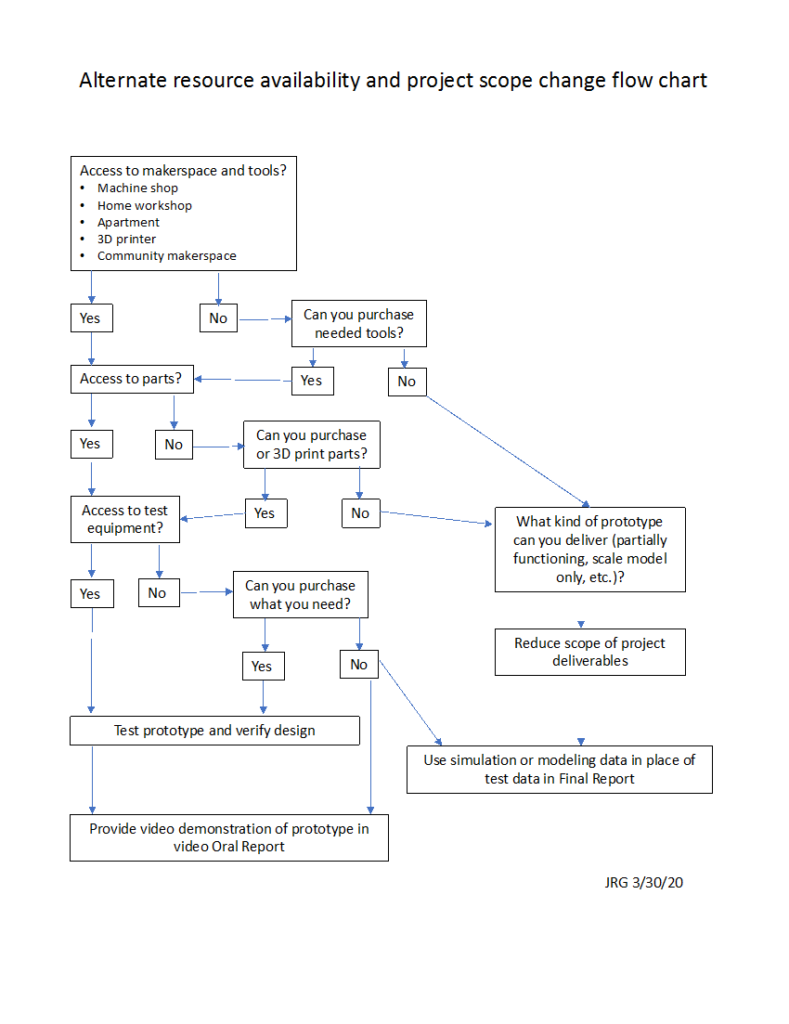At this time, many (if not all)
colleges and universities are on lockdown, students have returned home, and
classes have transitioned to online instruction. Students in capstone design
courses around the country have no access to their school’s maker spaces and
test equipment. Their prototype parts may be stored in a locked maker space,
making it difficult to build, test, and deliver prototypes to sponsors or
clients at the end of the semester.
In my opinion, our priority
as instructors should be to help our students complete as much of their
projects as possible with a focus on meeting the course learning objectives so
they can successfully complete the course and graduate on time. If the lack of
prototyping resources prevents completion and delivery of the final prototype,
we may need to be flexible and modify the scope of individual projects and
course deliverables (such as the final prototype) to accept what teams are able
to deliver at the end of the semester with the alternate resources that they may
have access to. However, we should not allow students to “give up” and conclude
that no further progress can be made on their projects due to the lack of
resources.
The COVID-19 pandemic and the
resulting stay-at-home orders have provided an ongoing real-time, real-world
lesson in contingency planning and finding alternate resources to complete
projects. This
situation can be used as a learning opportunity (without causing additional
stress to students). Students should be encouraged do
what they can to make as much progress on their projects as possible and not be
told to stop work due to lack of normally available resources. While we, as
capstone design instructors, can help students find these alternate resources,
students should be asked to do what they can to investigate potential alternate
resources, too.
At Marquette University, my capstone design colleagues and I have asked students to be creative and consider alternate resources that might be available to them during this lockdown, but would not require violating social distancing practices or put their health in jeopardy. These might include:
- Maker spaces: home workshop, apartment, project sponsor’s machine shop, community maker spaces (only if social distancing is possible).
- Test equipment: items they might have at home (timers, scales, tape measures, multimeters, etc.) that can be used for measurements and tests to support design verification activities. Simulation and modeling software may be available for use on their laptop computers.
- Prototype parts: materials, supplies, and parts that are locked in the school’s maker space and inaccessible. Students could order duplicates and have them shipped to their homes (if project budgets allow for this).
- Tools for prototype construction: items a team may need to complete their prototypes. Inexpensive models of soldering irons, multimeters, or other tools can be ordered to be delivered to one of their member’s home (if project budgets allow for this).
- Design software: CAD software needed to design prototype parts. Students may be able to obtain licenses to use CAD software on their laptop computers. If so, they can send files to 3D printing services to have parts made. Some students have their own 3D printers and could make their parts while at home.

After reviewing these potential alternate resources, the teams, the course instructors, and their faculty project advisors may conclude that the team does not have access to these alternate resources. Figure 1 documents the thought process that we used to help 1) students determine if they have the resources needed to complete their projects as originally planned, and 2) us as instructors to determine if changes to the scope of the projects were needed. Some teams will be able to complete their prototypes without these resources due to planning ahead, earlier prototype construction, ability to write code remotely, storage of prototype parts in their apartments, and other factors. However, if some teams truly cannot complete their prototypes, then it is important to consider this when grading and not penalize the team. As instructors, we need to reduce stress among students and be flexible and accommodating as possible. Each project is different, at different stages of design, and should be considered separately when assigning grades and determining if a change to the scope of a project and course deliverables (such as final reports and prototypes) is appropriate. Accommodations that we will be making include accepting the following:
- Design Verification: simulations and mathematical
modeling data (FMEA, circuit analyses, etc.) if actual test data is not
available due to inability to test the prototype. - Final Prototypes: scale models, detailed CAD
drawings and/or renderings, and partially functioning or nonfunctioning
prototypes (mock-ups) if prototypes cannot be completed.
If teams are unable to construct and test their prototypes, they will be asked to include a section in their final written and oral reports that addresses the potential alternate resources that they identified and investigated, and why these resources were not enough to allow them to complete their prototypes.
Finally, it is easier to manage a project when things are going well. Project management skills are demonstrated when a team finds ways to get around barriers and solve problems. We don’t want our students to give up when faced with challenges. In the current situation there are some project tasks that they can still do without a maker space (software development, developing test procedures for verification tests, generating improved designs, etc.). Finding creative, nonconventional ways to get around barriers and advance towards a goal will be helpful to students in completing their capstone design projects, and in their personal and professional lives.
Acknowledgment: I would like to thank my capstone design course colleagues, Dr. Vikram Cariapa, and Dr. Chandana Tamma at Marquette University for their contributions towards establishing the thought process depicted in Figure 1.


